Module 11 Unit 1 教学课件-外语教研版中学英语七年级下
文档属性
| 名称 | Module 11 Unit 1 教学课件-外语教研版中学英语七年级下 |
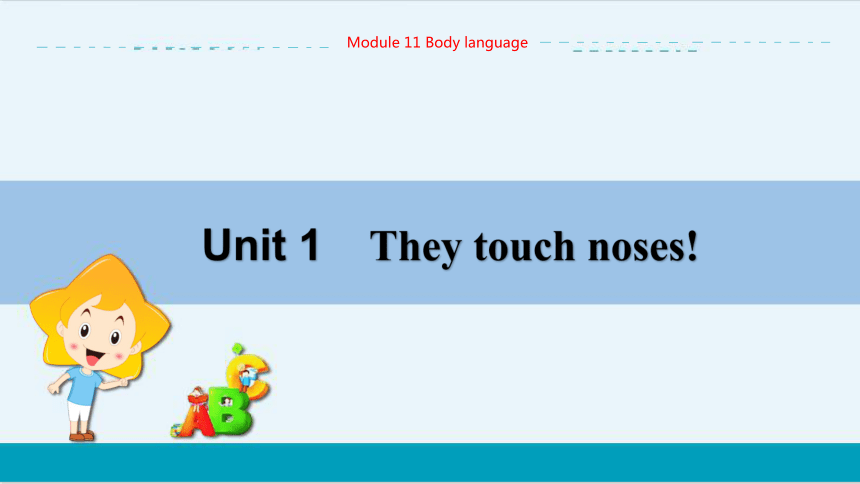
|
|
| 格式 | pptx | ||
| 文件大小 | 3.5MB | ||
| 资源类型 | 试卷 | ||
| 版本资源 | 外研版 | ||
| 科目 | 英语 | ||
| 更新时间 | 2024-02-21 19:05:49 | ||
图片预览

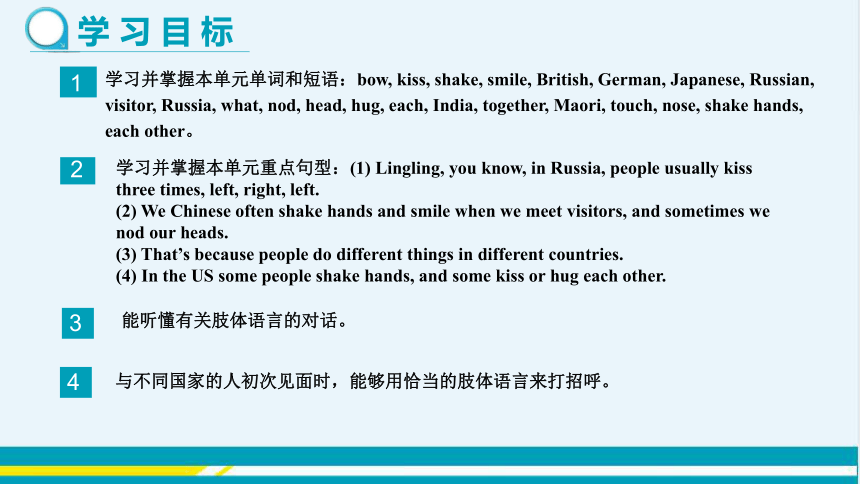
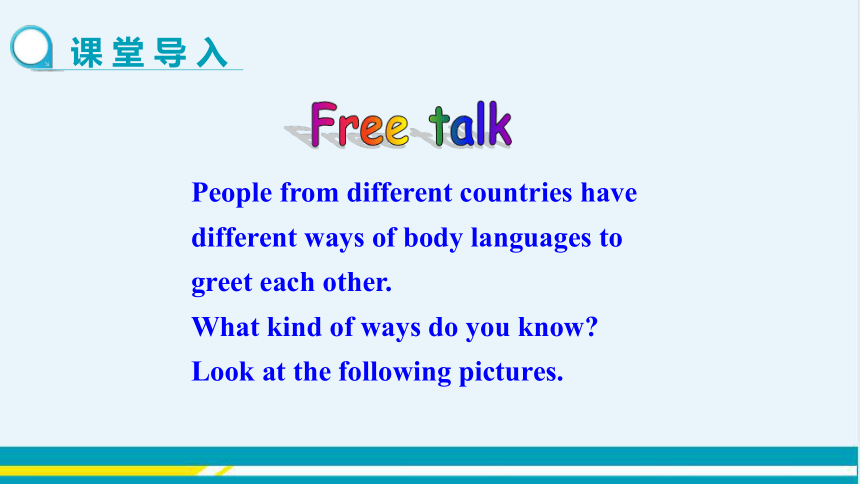
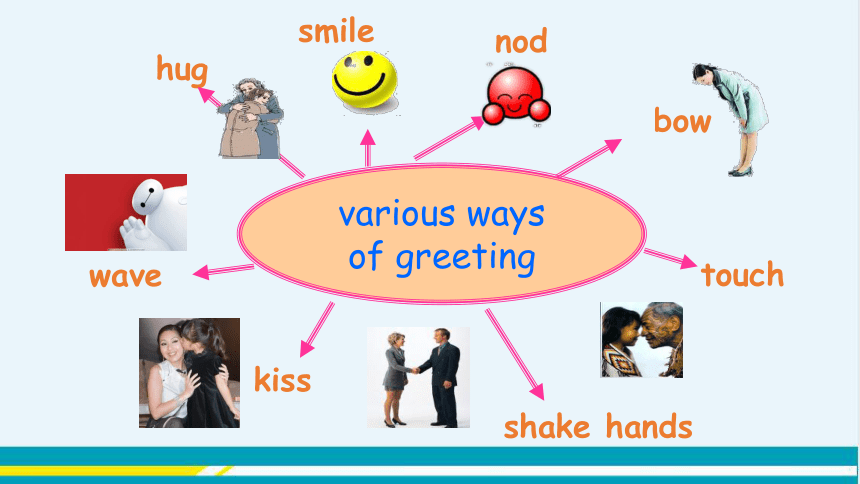
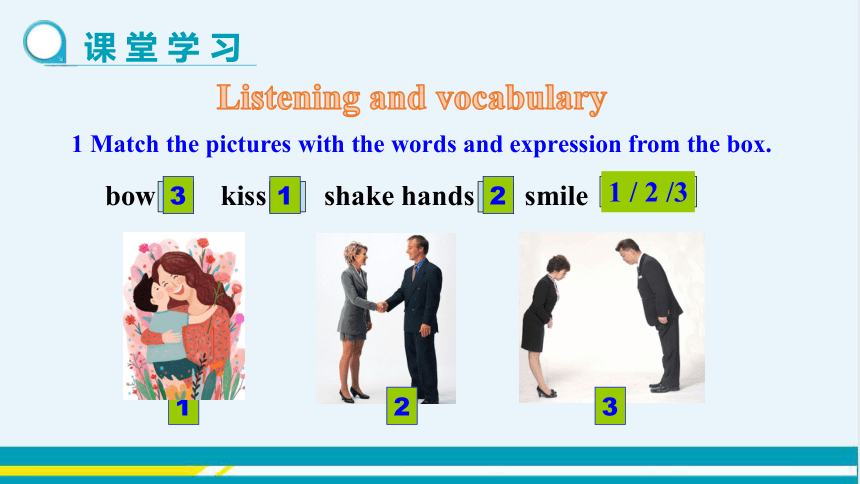

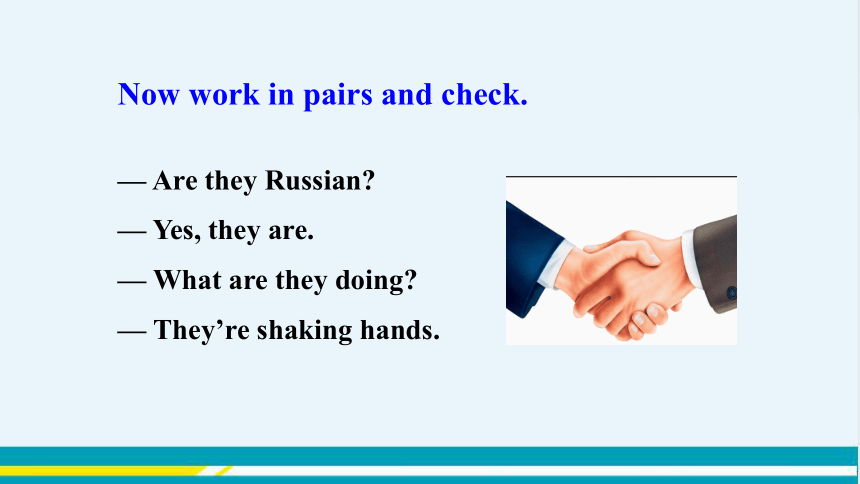
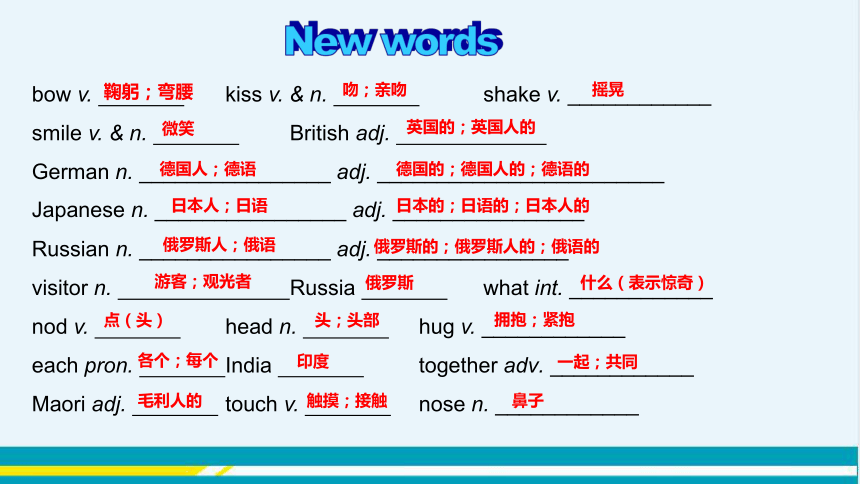
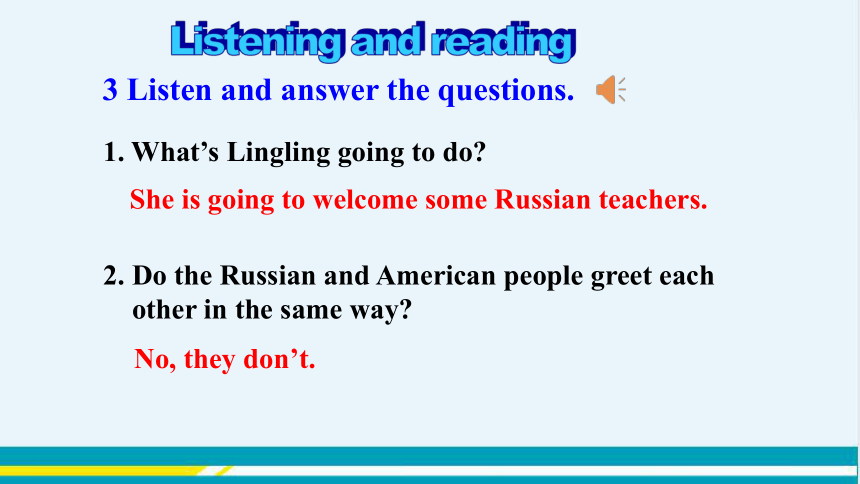
文档简介
(共26张PPT)
Unit 1 They touch noses!
Module 11 Body language
学 习 目 标
学习并掌握本单元单词和短语:bow, kiss, shake, smile, British, German, Japanese, Russian, visitor, Russia, what, nod, head, hug, each, India, together, Maori, touch, nose, shake hands, each other。
1
3
2
学习并掌握本单元重点句型:(1) Lingling, you know, in Russia, people usually kiss three times, left, right, left.
(2) We Chinese often shake hands and smile when we meet visitors, and sometimes we nod our heads.
(3) That’s because people do different things in different countries.
(4) In the US some people shake hands, and some kiss or hug each other.
能听懂有关肢体语言的对话。
4
与不同国家的人初次见面时,能够用恰当的肢体语言来打招呼。
课 堂 导 入
People from different countries have different ways of body languages to greet each other.
What kind of ways do you know
Look at the following pictures.
various ways
of greeting
smile
shake hands
hug
wave
kiss
bow
touch
nod
1 Match the pictures with the words and expression from the box.
bow kiss shake hands smile
1
2
3
1
2
3
1 / 2 /3
课 堂 学 习
Listening and vocabulary
2 Listen and match the pictures with the nationality.
British French
German Japanese
Russian
1
3
2
Now work in pairs and check.
— Are they Russian
— Yes, they are.
— What are they doing
— They’re shaking hands.
bow v. kiss v. & n. shake v. ____________
smile v. & n. British adj.
German n. ________________ adj. ________________________
Japanese n. ________________ adj. ________________
Russian n. ________________ adj. ________________
visitor n. Russia what int. ____________
nod v. head n. hug v. ____________
each pron. India together adv. ____________
Maori adj. touch v. nose n. ____________
New words
鞠躬;弯腰
吻;亲吻
摇晃
微笑
英国的;英国人的
德国人;德语
德国的;德国人的;德语的
日本人;日语
日本的;日语的;日本人的
俄罗斯人;俄语
俄罗斯的;俄罗斯人的;俄语的
游客;观光者
俄罗斯
什么(表示惊奇)
点(头)
头;头部
拥抱;紧抱
各个;每个
印度
一起;共同
毛利人的
触摸;接触
鼻子
3 Listen and answer the questions.
1. What’s Lingling going to do
She is going to welcome some Russian teachers.
2. Do the Russian and American people greet each
other in the same way
No, they don’t.
Listening and reading
Read and check the sentences.
1. People in Russia usually kiss the visitors three times, right, left, right.
2. We Chinese often shake hands and smile when we meet visitors.
3. We Chinese never kiss the visitors.
4. People in the US shake hands, and some kiss or hug each other.
5. People put their hands together and nod their heads in India.
6. Maori people touch noses when they meet.
×
√
√
√
√
√
India kiss Russia together touch visitor
Now complete the table with the correct form of the words from the box.
In China, people shake hands and smile
when they meet ________.
American people shake hands and sometimes ______ In ______, people put their hands ___________ and nod their heads In ______, people kiss each other three times Maori people _______ noses India
Russia
visitors
touch
together
kiss
Everyday English
What!
I don’t know that!
什么!(表示吃惊)
我不知道啊!
People in different countries may use different body language to express (表达) the same meaning(意思) and feelings(感受). When you speak with people from other countries, try to understand(理解) and respect (尊重) their body language.
Learning to learn
A smile is the most beautiful language
in the world!
Language points
time在此作可数名词,意为“次数”,复数形式为times。在英语中,表示一次、两次分别用once, twice。三次及以上,用“基数词+times”。
I've been to Beijing three times.
我去过北京三次。
I don't know him well; I've only met him twice.
我跟他不熟悉,只见过他两次。
Lingling, you know, in Russia, people usually kiss three times, left, right, left.
玲玲,你知道的,在俄罗斯人们通常亲吻三次,左边、右边、左边。
(1) shake此处用作及物动词,意为“握手”,shake hands with sb. 意为“与某人握手”。 shake的过去
式为shook。
Do people in America shake hands when they meet?美国人见面时握手吗?
The two teams shake hands and sit down.
两支队伍握手并坐下。
2. We Chinese often shake hands and smile when we meet visitors, and sometimes we nod our heads.我们中国人在见到来访者时,经常握手并微笑,有时我们点头。
(2)smile v. & n. 微笑
① smile 作动词时,常构成短语 smile at,意为“对……微笑”。
② smile 作名词时,常构成短语 with a smile,意为“面带微笑”。
③ smile 与 laugh 的区别:smile 一般是无声的微笑;laugh 一般是有声的笑、大笑,laugh at 意为“嘲笑”。
(3) nod作动词,意为“(点)头”。其过去式和过去分词均为nodded;现在分词为nodding。
搭配:nod one’s head 某人点头;nod to sb. 向某人点头示意。
Mary nodded her head slowly.
玛丽慢慢地点了点头。
Mary nodded to me just now.
玛丽刚才向我点头示意。
3. That's because people do different things in different countries.
That's because ... 那是因为……
because 引导表语从句,作 is 的表语,表示某事发生的原因。
He was late again. That's because he got up late.
他又迟到了。那是因为他起床很晚。
My son felt sad. That's because I wasn't at home.
我的儿子觉得难过。那是因为我不在家。
那是因为在不同的国家,人们做不同的事情。
4. In the US some people shake hands, and some kiss or hug
each other.在美国,一些人握手,一些人亲吻或者拥抱彼此。
(1) each other 意为“相互;彼此”,相当于one another。
We respect each other/one another. 我们互相尊重。
(2) each 此处用作代词,意为“每个”,强调个体,指两者或两者以上中的每一个。each of 意为“……中的每一个”,其后可接代词/名词的复数形式,若接名词,名词前需加限定词。该结构作主语时,谓语动词习惯上使用第三人称单数形式。
I believe that each of us can do a lot of things for our school.
我相信我们每个人都可以为我们的学校做很多事情。
Pronunciation and speaking
4 Listen and repeat.
Chinese each French teacher touch
British shake
people
French
British
[t ]
[ ]
[pl]
[fr]
[br]
5 Work in groups. Talk about what you do and say
when you meet:
your teacher
your head teacher
your parents after school
your best friend
your best friend’s parents
your favourite film star
a visitor to your school
an American
a Russian
— What do you do and say when you meet your teacher in the morning
— I smile and say good morning.
课 堂 达 标
I.根据首字母及句子意思,填入恰当的词。
1. “Welcome!”, she s_____ hands and smiles.
2. She came and gave her grandpa’s a h___.
3. If you agree my ideas, you n__ your head.
4. Maori people in New Zealand t____ noses when they meet.
5. They b__ to their king every morning.
6.She s_____ when she heard the good news.
hakes
ug
od
ouch
ow
miled
II.根据根据句意和汉语提示写单词。
1. 那是因为我们都累了。
________ ________ we are all tired.
2. 你知道他们来自哪里吗?
Do you know ______ ______ ________ from
3. 因为胜利,他们彼此拥抱。
They ______ ______ ______ for the success.
4. 如果你看见他们了,就点点头。
If you see them, please ______ ______ ______.
That’s because
where they are/come
hugged each other
nod your head
Ⅲ.单项填空
① Our teacher came into the classroom ______.
A. with smile B. with smiles
C. with a smile D. in a smile
② Many people _______ when they heard the joke.
A. laugh at B. smile at
C. laughed D. smiled at
C
C
Read and retell the conbersation.
2.Remember the words and expressions
of Unit 1.
3.Preview the words and expressions of Unit 2.
Homework
Thank you !
Unit 1 They touch noses!
Module 11 Body language
学 习 目 标
学习并掌握本单元单词和短语:bow, kiss, shake, smile, British, German, Japanese, Russian, visitor, Russia, what, nod, head, hug, each, India, together, Maori, touch, nose, shake hands, each other。
1
3
2
学习并掌握本单元重点句型:(1) Lingling, you know, in Russia, people usually kiss three times, left, right, left.
(2) We Chinese often shake hands and smile when we meet visitors, and sometimes we nod our heads.
(3) That’s because people do different things in different countries.
(4) In the US some people shake hands, and some kiss or hug each other.
能听懂有关肢体语言的对话。
4
与不同国家的人初次见面时,能够用恰当的肢体语言来打招呼。
课 堂 导 入
People from different countries have different ways of body languages to greet each other.
What kind of ways do you know
Look at the following pictures.
various ways
of greeting
smile
shake hands
hug
wave
kiss
bow
touch
nod
1 Match the pictures with the words and expression from the box.
bow kiss shake hands smile
1
2
3
1
2
3
1 / 2 /3
课 堂 学 习
Listening and vocabulary
2 Listen and match the pictures with the nationality.
British French
German Japanese
Russian
1
3
2
Now work in pairs and check.
— Are they Russian
— Yes, they are.
— What are they doing
— They’re shaking hands.
bow v. kiss v. & n. shake v. ____________
smile v. & n. British adj.
German n. ________________ adj. ________________________
Japanese n. ________________ adj. ________________
Russian n. ________________ adj. ________________
visitor n. Russia what int. ____________
nod v. head n. hug v. ____________
each pron. India together adv. ____________
Maori adj. touch v. nose n. ____________
New words
鞠躬;弯腰
吻;亲吻
摇晃
微笑
英国的;英国人的
德国人;德语
德国的;德国人的;德语的
日本人;日语
日本的;日语的;日本人的
俄罗斯人;俄语
俄罗斯的;俄罗斯人的;俄语的
游客;观光者
俄罗斯
什么(表示惊奇)
点(头)
头;头部
拥抱;紧抱
各个;每个
印度
一起;共同
毛利人的
触摸;接触
鼻子
3 Listen and answer the questions.
1. What’s Lingling going to do
She is going to welcome some Russian teachers.
2. Do the Russian and American people greet each
other in the same way
No, they don’t.
Listening and reading
Read and check the sentences.
1. People in Russia usually kiss the visitors three times, right, left, right.
2. We Chinese often shake hands and smile when we meet visitors.
3. We Chinese never kiss the visitors.
4. People in the US shake hands, and some kiss or hug each other.
5. People put their hands together and nod their heads in India.
6. Maori people touch noses when they meet.
×
√
√
√
√
√
India kiss Russia together touch visitor
Now complete the table with the correct form of the words from the box.
In China, people shake hands and smile
when they meet ________.
American people shake hands and sometimes ______ In ______, people put their hands ___________ and nod their heads In ______, people kiss each other three times Maori people _______ noses India
Russia
visitors
touch
together
kiss
Everyday English
What!
I don’t know that!
什么!(表示吃惊)
我不知道啊!
People in different countries may use different body language to express (表达) the same meaning(意思) and feelings(感受). When you speak with people from other countries, try to understand(理解) and respect (尊重) their body language.
Learning to learn
A smile is the most beautiful language
in the world!
Language points
time在此作可数名词,意为“次数”,复数形式为times。在英语中,表示一次、两次分别用once, twice。三次及以上,用“基数词+times”。
I've been to Beijing three times.
我去过北京三次。
I don't know him well; I've only met him twice.
我跟他不熟悉,只见过他两次。
Lingling, you know, in Russia, people usually kiss three times, left, right, left.
玲玲,你知道的,在俄罗斯人们通常亲吻三次,左边、右边、左边。
(1) shake此处用作及物动词,意为“握手”,shake hands with sb. 意为“与某人握手”。 shake的过去
式为shook。
Do people in America shake hands when they meet?美国人见面时握手吗?
The two teams shake hands and sit down.
两支队伍握手并坐下。
2. We Chinese often shake hands and smile when we meet visitors, and sometimes we nod our heads.我们中国人在见到来访者时,经常握手并微笑,有时我们点头。
(2)smile v. & n. 微笑
① smile 作动词时,常构成短语 smile at,意为“对……微笑”。
② smile 作名词时,常构成短语 with a smile,意为“面带微笑”。
③ smile 与 laugh 的区别:smile 一般是无声的微笑;laugh 一般是有声的笑、大笑,laugh at 意为“嘲笑”。
(3) nod作动词,意为“(点)头”。其过去式和过去分词均为nodded;现在分词为nodding。
搭配:nod one’s head 某人点头;nod to sb. 向某人点头示意。
Mary nodded her head slowly.
玛丽慢慢地点了点头。
Mary nodded to me just now.
玛丽刚才向我点头示意。
3. That's because people do different things in different countries.
That's because ... 那是因为……
because 引导表语从句,作 is 的表语,表示某事发生的原因。
He was late again. That's because he got up late.
他又迟到了。那是因为他起床很晚。
My son felt sad. That's because I wasn't at home.
我的儿子觉得难过。那是因为我不在家。
那是因为在不同的国家,人们做不同的事情。
4. In the US some people shake hands, and some kiss or hug
each other.在美国,一些人握手,一些人亲吻或者拥抱彼此。
(1) each other 意为“相互;彼此”,相当于one another。
We respect each other/one another. 我们互相尊重。
(2) each 此处用作代词,意为“每个”,强调个体,指两者或两者以上中的每一个。each of 意为“……中的每一个”,其后可接代词/名词的复数形式,若接名词,名词前需加限定词。该结构作主语时,谓语动词习惯上使用第三人称单数形式。
I believe that each of us can do a lot of things for our school.
我相信我们每个人都可以为我们的学校做很多事情。
Pronunciation and speaking
4 Listen and repeat.
Chinese each French teacher touch
British shake
people
French
British
[t ]
[ ]
[pl]
[fr]
[br]
5 Work in groups. Talk about what you do and say
when you meet:
your teacher
your head teacher
your parents after school
your best friend
your best friend’s parents
your favourite film star
a visitor to your school
an American
a Russian
— What do you do and say when you meet your teacher in the morning
— I smile and say good morning.
课 堂 达 标
I.根据首字母及句子意思,填入恰当的词。
1. “Welcome!”, she s_____ hands and smiles.
2. She came and gave her grandpa’s a h___.
3. If you agree my ideas, you n__ your head.
4. Maori people in New Zealand t____ noses when they meet.
5. They b__ to their king every morning.
6.She s_____ when she heard the good news.
hakes
ug
od
ouch
ow
miled
II.根据根据句意和汉语提示写单词。
1. 那是因为我们都累了。
________ ________ we are all tired.
2. 你知道他们来自哪里吗?
Do you know ______ ______ ________ from
3. 因为胜利,他们彼此拥抱。
They ______ ______ ______ for the success.
4. 如果你看见他们了,就点点头。
If you see them, please ______ ______ ______.
That’s because
where they are/come
hugged each other
nod your head
Ⅲ.单项填空
① Our teacher came into the classroom ______.
A. with smile B. with smiles
C. with a smile D. in a smile
② Many people _______ when they heard the joke.
A. laugh at B. smile at
C. laughed D. smiled at
C
C
Read and retell the conbersation.
2.Remember the words and expressions
of Unit 1.
3.Preview the words and expressions of Unit 2.
Homework
Thank you !
同课章节目录
- Module 1 Lost and found
- Unit 1 Whose bag is this?
- Unit 2 Are they yours?
- Unit 3 Language in use
- Module 2 What can you do ?
- Unit 1 I can play the piano
- Unit 2 I can run really fast
- Unit 3 Language in use
- Module 3 Making plans
- Unit 1 What are you going to do at the weekends?
- Unit 2 We're going to cheer the players.
- Unit 3 Language in use
- Module 4 Life in the future
- Unit 1 Everyone will study at home
- Unit 2 Every family will have a small plane.
- Unit 3 Language in use
- Module 5 Shopping
- Unit 1 What can I do for you?
- Unit 2 You can buy everything on the Internet
- Unit 3 Language in use
- Module 6 Around town
- Unit 1 Could you tell me how to get to the Nationa
- Unit 2 The London Eye is on your right.
- Unit 3 Language in use
- Revision module A
- Module 7 My past life
- Unit 1 I was born in a small village.
- Unit 2 I was born in Quincy.
- Unit 3 Language in use
- Module 8 Story time
- Unit 1 Once upon a time….
- Unit 2 Goldilocks hurried out of the house.
- Unit 3 Language in use
- Module 9 Life history
- Unit 1 He left school and began work at the age of
- Unit 2 He decided to be an actor.
- Unit 3 Language in use
- Module 10 A holiday journey
- Unit 1 What did you do?
- Unit 2 This morning we took a walk.
- Unit 3 Language in use
- Module 11 Body language
- Unit 1 They touch noses!
- Unit 2 Here are some ways to welcome them.
- Unit 3 Language in use
- Module 12 Western music
- Unit 1 It's so beautiful!
- Unit 2 Vienna is the centre of European classical
- Unit 3 Language in use
- Revision module B
